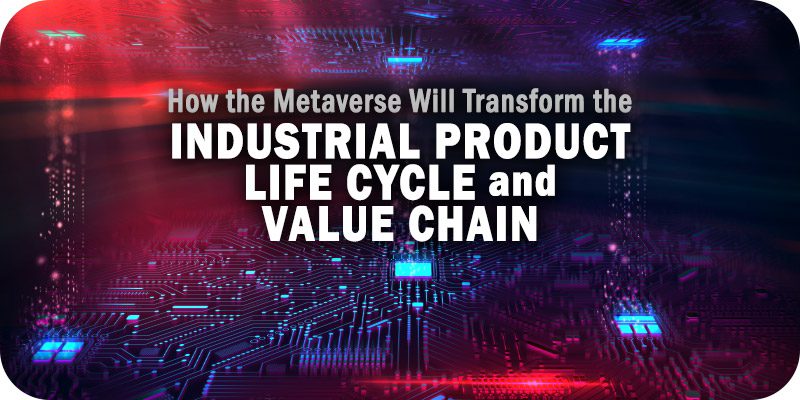How the Metaverse Will Transform the Industrial Product Life Cycle and Value Chain


As part of Solutions Review’s Contributed Content Series—a collection of articles written by industry thought leaders in maturing software categories—Jiani Zhang, the Executive Vice President and Chief Software Officer at Capgemini Engineering, explores how the metaverse might change the industrial product life cycle and value chain.
In the modern era of technological innovation, enterprises across industries have embraced digital transformation to engage with customers on a deeper level. More recently, immersive experiences and the metaverse are top of mind for leaders seeking new business models and improved operations.
Research shows that 77 percent of consumers expect immersive experiences to impact how they interact with people, brands, and services and that organizations recognize the broad opportunities it presents to drive value across the business, specifically in their internal operations. While the consumer metaverse may receive all the fanfare, the dynamic spaces of the industrial metaverse are coming increasingly into focus for its potential to transform the entire value chain of product life cycle development.
Unlike the consumer and business uses of metaverse technology, the industrial metaverse is the application of augmented and extended reality to virtually represent a physical asset to understand the manifestation of that asset in the real world. Operating hand in hand with digital twins, the use of metaversal technology from an industrial standpoint leverages technology to interact with, experience, and understand an industrial asset—such as a large machine or an engine—so that manufacturers can determine how it is designed and made, how it performs, and how it must be serviced.
Beyond transforming and streamlining the entire manufacturing and operations process, this technology allows manufacturers to link together a physical project from its inception across its whole life cycle and value chain.
Streamlining Design Through Research and Development
Imagine you are designing a robotic arm. During this process, the architect of this product will outline the capabilities required of this arm. For example, this arm must be able to move at a certain angle or speed, carry a certain weight, and operate in certain temperatures.
For these functions to be possible, the engineer would determine a series of components—metal, pivots, etc.—needed for this level of functionality. With the introduction of the metaverse and immersive technologies, the research and development process can be streamlined significantly by applying a digital simulation that not only shows the physical attributes of the arm but incorporates the physics and chemistry of the product to evaluate how it reacts and interacts as the materials change.
For example, if one piece of the arm is consistently stressed by friction or impact, that will factor into the material used—such as the tensile strength or the pressure needed to withstand impact. Understanding these materials’ physical and chemical makeup through a digital representation can quickly provide insights into the components best suited for these conditions—thus streamlining the entire design process.
Optimizing Factory Planning Through Digital Layouts
Once the design phase is complete, the product moves into the manufacturing process. Augmented metaverse technology has several potential manufacturing benefits—specifically from a supply chain and factory planning perspective.
Optimizing the factory planning of assembly lines is a significant challenge for plant managers. With metaverse technology, plant managers can digitally map the factory floor to determine where human intervention is needed, where it is safe for plant personnel to enter and exit the facility, where parts can be picked up, where to station crews, and beyond.
The ability to digitally optimize the manufacturing space and plant layout is similar to the simulation of autonomous vehicle testing. For example, autonomous vehicle developers can digitally map traffic patterns, red lights, and stop signs to assess driving conditions. What will the traffic patterns be if fifty cars are on the road, and how should the autonomous vehicle react? The same can be said for factory planning. If there are 50 workers on the factory floor and ten machines working, how can the layout of this facility be optimized so that they can move and operate efficiently and safely? All of this can be digitally simulated before the start of the manufacturing process, allowing for enhanced planning and operations.
Predicting Servicing with Environment Simulation
Beyond the factory floor, metaverse capabilities can extend to product servicing and maintenance once it has been put to their intended use. This involves hazard planning, environmental simulation, and maintenance cycling to ensure that the product is undergoing the proper upkeep and will maintain its effectiveness.
For example, suppose the robotic arm was developed to need servicing after 100,000 uses in a normal (57-degree Fahrenheit) temperature. In that case, metaverse technology can simulate how this product might perform under arctic conditions. Perhaps in that simulation, the device would fail after 5,000 uses, which indicates that servicing would be needed after one month instead of one year.
The product, in this case, a robotic arm, would function much differently depending on its exposure to the elements, extreme temperatures, chemical attributes, and beyond. Simulating various complex environments can provide invaluable information on the necessary maintenance and servicing cycles, how the service providers can plan for any potential hazards on their service routes (icy roads, road closures, etc.), and how that impacts their ability to provide maintenance.
Improving Training and Collaboration to Mitigate Risk
Another significant advantage of industrial metaverse capabilities is the impact on training and collaboration. One use case where this has been successful is drill operations. Before this technology, operators were sent into dark, unfamiliar, underground environments—with limited oxygen—to operate drills.
With metaverse and AR technology, this environment can be digitally simulated above ground without the pressure and danger of a high-stress environment. By running training simulations above ground, these operators can become familiar with this environment without the associated risks while still receiving all necessary training and principles. These types of training and collaboration tools have significantly improved the safety of industrial jobs and can grow the talent pool because there are fewer concerns regarding personal risk.
At a high level, the future of the industrial metaverse will blend the physical and digital worlds to transform the product life cycle as we know it. As these immersive technologies continue to evolve and grow, there has never been a greater opportunity to create bigger and better customer experiences. For leaders contemplating leaping the industrial metaverse—the time is now.























